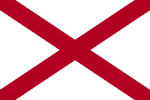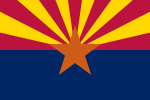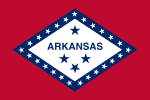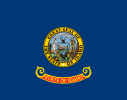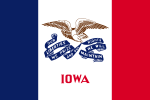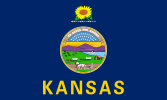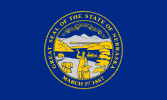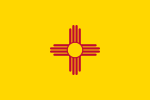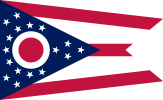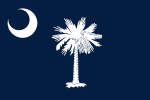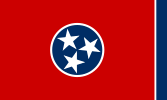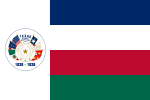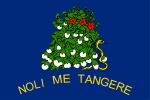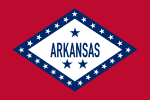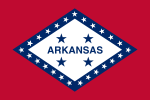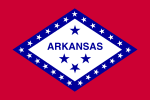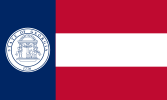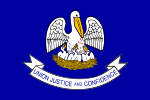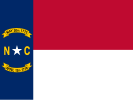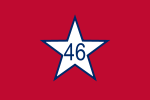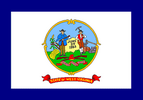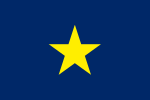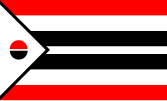Flags of the U.S. states and territories
From Wikipedia, the free encyclopedia
The flags of the U.S. states, territories, and the District of Columbia (Washington, D.C.) exhibit a variety of regional influences and local histories, as well as different styles and design principles. Modern U.S. state flags date from the turn of the 20th century, when states considered distinctive symbols for the 1893 World's Columbian Exposition in Chicago, Illinois. Most U.S. state flags were designed and adopted between 1893 and World War I.[1]

The most recently adopted state flag is that of Minnesota, adopted on May 11, 2024, while the most recently adopted territorial flag is that of the Northern Mariana Islands, adopted on July 1, 1985. The flag of the District of Columbia was adopted in 1938. Recent legislations in Massachusetts (2021) and Illinois (2024) have started the process of redesigning their state flag. Michigan also has plans to redesign their flag in the future, but this has not been confirmed. Maine had put a flag redesign on the ballot in November 2024, but the redesign had failed the vote.[2][3]
Despite a variety of designs, the majority of the states' flags share the same design pattern consisting of the state seal superimposed on a monochrome background, commonly a shade of blue, which remains a source of criticism from vexillologists. According to a 2001 survey by the North American Vexillological Association, New Mexico has the best-designed flag of any U.S. state, U.S. territory, or Canadian province, while Georgia's state flag was rated the worst (the latter of which has been changed since the survey was conducted).[4]
Current state flags
Summarize
Perspective
Listed alphabetically with their respective date of adoption.
Flag of Alabama
(February 16, 1895)[5]Flag of Alaska
(May 2, 1927)Flag of Arizona
(February 27, 1917)Flag of Arkansas
(February 26, 1913)[6]Flag of California
(February 3, 1911)Flag of Colorado
(June 5, 1911)[7]Flag of Connecticut
(September 9, 1897)Flag of Delaware
(July 24, 1913)[8]Flag of Florida
(November 6, 1900)[9]Flag of Georgia
(February 19, 2003)[10]Flag of Hawaii
(December 29, 1844)Flag of Idaho
(March 12, 1907)[11]Flag of Illinois
(September 17, 1969)[12]Flag of Indiana
(May 31, 1917)[13]Flag of Iowa
(March 29, 1921)Flag of Kansas
(September 24, 1961)Flag of Kentucky
(March 26, 1918)[14]Flag of Louisiana
(July 1, 1912)[15]Flag of Maine
(February 23, 1909)Flag of Maryland
(March 9, 1904)[16]Flag of Massachusetts
(July 3, 1971)Flag of Michigan
(August 1, 1911)Flag of Minnesota
(May 11, 2024)[17]Flag of Mississippi
(January 11, 2021)[18]Flag of Missouri
(March 22, 1913)[19]Flag of Montana
(July 1, 1981)Flag of Nebraska
(April 2, 1925)Flag of Nevada
(July 25, 1991)Flag of New Hampshire
(1909)[20]Flag of New Jersey
(May 11, 1896)Flag of New Mexico
(March 15, 1925)Flag of New York
(April 2, 1901)[21]Flag of North Carolina
(March 9, 1885)Flag of North Dakota
(March 11, 1911)Flag of Ohio
(May 9, 1902)[22]Flag of Oklahoma
(1941)[23]Flag of Oregon (obverse)
(April 15, 1925)Flag of Oregon (reverse)
Flag of Pennsylvania
(June 13, 1907)[24]Flag of Rhode Island
(November 1, 1897)Flag of South Carolina
(January 28, 1861)Flag of South Dakota
(November 9, 1992)Flag of Tennessee
(April 17, 1905)[25]Flag of Texas
(January 25, 1839)[26]Flag of Utah
(March 9, 2024)[27]Flag of Vermont
(June 1, 1923)[28]Flag of Virginia
(March 28, 1912)Flag of Washington
(March 5, 1923)Flag of West Virginia
(March 7, 1929)Flag of Wisconsin
(May 1, 1981)[29]Flag of Wyoming
(January 31, 1917)
Current federal district flag
This is the current flag of the District of Columbia.
Current territory flags
These are the current official flags of the five permanently inhabited territories of the United States.
- Flag of American Samoa
(April 17, 1960) - Flag of Guam
(February 9, 1948) - Flag of the Northern Mariana Islands
(July 1, 1985) - Flag of Puerto Rico
(July 22, 1952) - Flag of the U.S. Virgin Islands
(May 17, 1921)
Current state ensigns
Maine and Massachusetts have ensigns for use at sea.
Former state ensigns
- Former naval ensign of Massachusetts
(1775 – 1971)
Commemorative state flags
Historical state and territory flags
Summarize
Perspective
Former state flags
- Flag of Georgia
(January 31, 2001 – February 19, 2003) - Flag of Idaho before second standardization
(March 15, 1927 – March 1957) - Flag of Kentucky before standardization
(1918 – 1962) - Flag of Maine
(1901 – 1909) - Flag of Mississippi
(1996 – June 30, 2020) - Flag of Montana
(1905 – July 1, 1981) - Flag of New Mexico
(1915-1925) - Flag of New York
(1896 – April 2, 1901) - Flag of New York before standardization
(April 2, 1901 – April 2020) - Flag of Rhode Island
(1877 – 1882) - Flag of Rhode Island
(1882 – November 1, 1897) - Flag of South Carolina before first standardization
(January 28, 1861 – 1910) - Flag of South Carolina before second standardization
(1910 – 1940) - Flag of South Dakota before first redesign
(obverse, 1909 – 1963) - Flag of South Dakota
(reverse, 1909 – 1963) - Flag of South Dakota before second redesign
(1963 – November 9, 1992) - Flag of Utah
(March 9, 1911 – March 11, 1913) - Flag of Utah
(March 11, 1913 – May 6, 1922) - Flag of Utah
(May 6, 1922 – February 16, 2011) - Flag of Utah
(February 16, 2011 – March 9, 2024) - Flag of West Virginia
(reverse, 1907 – March 7, 1929)
Former territory flags
- Former flag of the Panama Canal Zone
(1915—1979) - Flag of the Insular Government of the Philippine Islands
(1919–1936) - Flag of the Commonwealth of the Philippines
(1936–1946) - Former flag of the Trust Territory of the Pacific Islands
(1965 – 1980) - Former flag of the Northern Mariana Islands
(1976 – 1981) - Former flag of the Northern Mariana Islands
(1976 – 1989) - Original flag of Puerto Rico
(1895 – 1952) - Former flag of Puerto Rico
(1952 – 1995)
Pre-statehood flags
California, Texas, and Hawaii were independent nations with flags before entering the union. The Utah Territory had a flag before receiving statehood.
- California Republic flag
(June 14 – July 9, 1846) - Republic of Hawaii flag
(1816–1845) - Republic of Texas flag
(1836 – 1839) - Republic of Texas flag
(1839 – 1845) - Flag of Utah Territory
(1850 – March 1903)
Native American flags
Many Native American nations have tribal sovereignty, with jurisdiction over their members and reserved land. Although reservations are on state land, the laws of the state(s) do not necessarily apply.[67] Below are the flags of some of the largest Indian tribes reservations by population and area:
- Flag of the Choctaw Nation
- Flag of Chinook Nation
- Flag of the Osage Nation
- Flag of the Northern Arapaho of the Wind River Indian Reservation
- Flag of Chickasaw Nation
- Flag of Hassanamisco Nipmuc
- Flag of the Pine Ridge Reservation
- Flag of Ninilchik Village Tribe
- Flag of Miccosukee
- Flag of Sac and Fox Nation
- Flag of Pascua Yaqui Tribe
- Flag of the Blackfeet Nation
- Flag of the Colorado River Indian Tribes
Unofficial flags of United States Minor Outlying Islands
The U.S. national flag is the official flag for all islands, atolls, and reefs composing the United States Minor Outlying Islands. However, unofficial flags are sometimes used to represent some of these insular areas:
See also
- Flag of the United States
- Flags of governors of the U.S. states
- List of flags of the United States (including county, city and historical flags)
- List of U.S. state, district, and territorial insignia
- Flags of the Confederate States
- Timeline of U.S. state and territory flags
- Proposed flags of U.S. states
Notes
References
External links
Wikiwand - on
Seamless Wikipedia browsing. On steroids.

